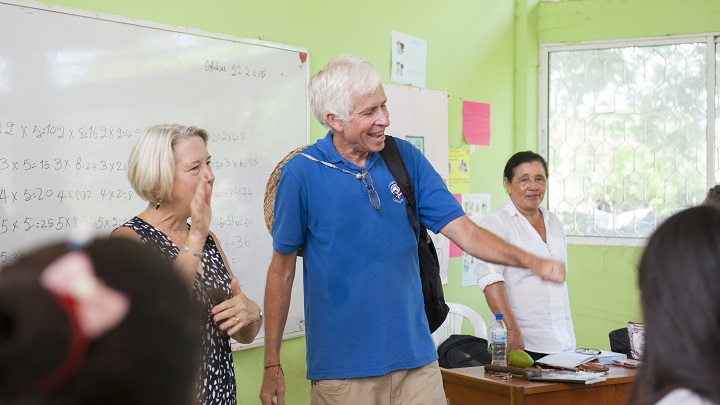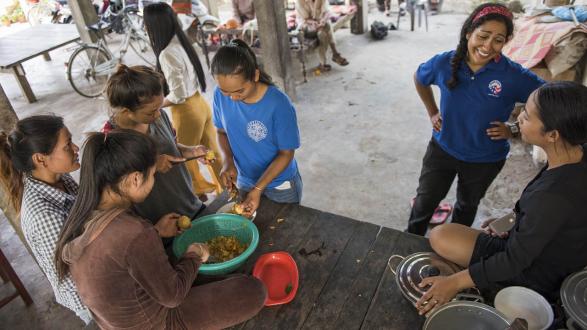In:
War, poverty, famine, disease, the fear of nuclear war – all those things that drove JFK to create the Peace Corps in 1961 still exist today. Indeed, one could argue that the stakes are even higher in 2016. The need for world peace and friendship is just as clear now as it was in 1961.
But the world we live in today is very different from the world in which the Peace Corps was created – to say nothing of the world 15, 25, 35 years from now. Globalization, terrorism, the refugee crisis, and climate change are triggering new concerns – and demand new responses.
Today, more than ever before, the security and economic prosperity of the United States is inextricably linked with that of other nations. And although the past 25 years have demonstrated the greatest development progress in the history of the world, billions still live in heart-wrenching poverty. Extreme poverty and social injustice lead to political and economic instability – conditions that foster hopelessness and breed violence.
Creating a culture of peace and prosperity begins with creating the conditions where peace can flourish.
We know that economically stable countries that respect the rights of its citizens are safer, more peaceful, more prosperous and better global partners. Creating a culture of peace and prosperity begins with creating the conditions where peace can flourish. For the Peace Corps, that means helping our host nations build capacity to address poverty, inequality, and lack of opportunity at the community level – at the “last mile” of development.
Over the past half-century, approximately 220,000 Volunteers have served in more than 140 host countries across the globe, working on issues ranging from empowering women and girls – to training and supporting the next generation of doctors, nurses and health workers – to fighting climate change in an increasingly interconnected world.
The scope of their work isn’t dictated by a far-away office in Washington. Instead, their projects are driven by the priorities of their communities, whether it is helping to stomp out malaria or connecting indigenous artisans with global markets.
You see, Peace Corps Volunteers do so much more than just their jobs.
Many live with host families. In their free time, they drink tea with village elders, and play soccer with the local kids. They get to know the pregnant mom next door. They learn to speak the local language and understand the local culture – and their presence in the community gives them the credibility and trust they need to do their work.
And slowly but surely, our Peace Corps Volunteers form deep, personal relationships of trust with the people they serve.
The human connection is still the most important aspect of our life-changing work.
Those bonds of trust lead to friendships that transcend time and space, building lifelong connections between Volunteers and their host communities.
The human connection is still the most important aspect of our life-changing work.
I think about Volunteers like Gene Rutan, a Los Angeles native whom I met in Colombia a few months ago. The son of missionaries, Gene lived and traveled in Central America for years before returning to California to work first as a mechanic, then as a high school Spanish teacher. And then, not long before his 60th birthday, he decided to fulfill a longtime aspiration and apply to the Peace Corps.
Gene’s primary job in his northern Colombian community is teaching English – working with elementary and high school students as well as mentoring the Colombian teachers, many of whom have trouble with the language themselves. But he has also somehow become known as the “fixer” in his town – whether it’s mending broken electrical systems, repairing outdated computers, or motivating unruly students to persist in their studies.

Walking around with Gene in his town was like walking around with Mister Rogers – everyone, from the children kicking soccer balls around in the dusty streets, to the grandmothers sitting out in the sun in front of their cement-block houses – seemed to know him, and everyone had a smile and a friendly greeting to share. “I have always liked to fix mechanical things,” Gene says. “I left a trail of parts wherever I went for many years before I learned to put them back together.” But as a Peace Corps Volunteer, he says, it’s the social and cultural challenges that have inspired him most – and it’s the relationships that he has built along the way, that have truly defined his experience.
Immersed in their communities, living their projects day in and day out, Peace Corps Volunteers experience – in a deeply personal way – the realities of living in poverty. Unemployment; lack of opportunity; ill health; political instability; hopelessness; lack of understanding – crippling fear – all these chip away at peace.
In the end, what Peace Corps Volunteers contribute most to their communities is unleashing the potential that is already there.
What sets Peace Corps Volunteers apart is that they refuse to accept these conditions as just the way things are. Or the way things have to be. As a result, they are uniquely positioned to identify the most critical windows of opportunity for positive change.
Inspiring a struggling student to stay in school may seem like a small thing, when you think about the challenges to peace faced by communities around the world – and communities here at home.
But time and again, history has shown us that the greatest tragedy in our world is not lack of resources but lack of dignity, opportunity and hope. In the end, what Peace Corps Volunteers contribute most to their communities is unleashing the potential that is already there – by providing youth with positive outlets for their energy and creativity; by nurturing the leaders of tomorrow; by reaching out to the rural, the undiscovered, those who, with just a little boost, can make a huge difference in their communities, their countries and their world.
____________________
Carrie Hessler-Radelet is the 19th Director of the Peace Corps. She was sworn in on June 25, 2014. Prior to this, she served as the agency’s acting Director and deputy director from 2010–14. Read more about her background and follow her on Twitter: @PeaceCorpsDir.
The views and opinions expressed here are those of the author and do not necessarily reflect the official policy or position of the Pacific Council.




